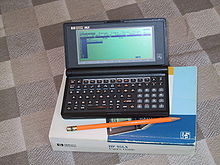HP 95LX
 Like most pocket computers, the HP 95LX owner's manual is larger and heavier than the computer itself. | |
| Also known as | Jaguar |
|---|---|
| Manufacturer | Hewlett-Packard[1] |
| Type | Palmtop PC |
| Release date | April 1991[2] |
| Introductory price | $550 |
| Discontinued | January 1, 2003 |
| Units shipped | 400,000 (estimated production run) |
| Operating system | Microsoft MS-DOS 3.22 |
| CPU | NEC V20 @ 5.37 MHz |
| Memory | 512 KB (F1000A) or 1 MB (F1010A)[3] |
| Removable storage | SRAM card (0.5MB - 32MB) |
| Display | 16 x 40 characters LCD screen (4.8 in x 1.8 in) |
| Graphics | 128 x 240 pixels(quarter-CGA resolution) monochrome STN , 2 scales |
| Sound | PC Speaker - Piezo |
| Input | Thumb keyboard w/80 keys & dedicated numeric keypad[4][5][6] |
| Connectivity | RS-232-compatible serial port, infrared port, PCMCIA 1.0 type II (3.3mm or 5mm) |
| Power | 2x AA-size removable batteries, 1x CR2032 coin cell backup, optional AC adapter |
| Dimensions | Length 8.5cm, Width 15.9cm, Height 2.6cm (3.4 inches x 6.3 inches x 1 inch)[4] |
| Mass | 11 ounces(312g) |
| Backward compatibility | Intel 8088 |
| Successor | HP 100LX |
The HP 95LX (F1000A, F1010A), also known as project Jaguar, was the first MS-DOS pocket computer or personal digital assistant, introduced by Hewlett-Packard in April 1991 in collaboration with Lotus Development Corporation.
The HP 95LX had an NEC V20 CPU (an Intel 8088 clone running at 5.37 MHz) with an Intel Corporation System on a chip (SoC) device. It cannot be considered completely PC-compatible because of its quarter-CGA (MDA) resolution LCD screen.[7] It ran Microsoft's MS-DOS version 3.22 and had Lotus 1-2-3 built in. Other software in read-only memory (ROM) included a calculator, an appointment calendar, a telecommunications program, and a simple text editor. It also included a CR 2032 lithium coin cell for memory backup when the two AA main batteries run out. For mass storage, the HP 95LX had a single PCMCIA slot which could hold a static RAM card (which had its own CR 2025 back-up coin cell). An RS-232-compatible serial port was provided, as well as an infrared port for printing on compatible models of Hewlett Packard printers.[8] In character mode, the display showed 16 lines of 40 characters and had no back light.
Successor models to the HP 95LX include the HP 100LX, HP Palmtop FX, HP 200LX, HP 1000CX, and HP OmniGo 700LX.
See also
- DIP Pocket PC
- Atari Portfolio
- Poqet PC
- Poqet PC Prime
- Poqet PC Plus
- ZEOS Pocket PC
- Yukyung Viliv N5
- Sub-notebook
- Netbook
- Palmtop PC
- Ultra-mobile PC
References
- ^ HP 95LX. (palmtop computer) (Evaluation), by Peter Francis, COMPUTE! ISSUE 136 / DECEMBER 1991 / PAGE 128
- ^ Hewlett-Packard 95LX computer, oldcomputers.net
- ^ 95LX, HP Computer Museum
- ^ a b HP 95LX: Remembering the early mobile DOS PC, By James Kendrick, 2015-04-07, ZDNet
- ^ HP95LX - Page 76, 16 Dec 1991, How we test Palmtop computers, InfoWorld
- ^ HP 95LX, Old Organizers Collection, Pictures
- ^ DOS Palmtop: HP 95LX Details and specs, List of DOS-based palmtop computers, due to its main flaw - the MDA graphics (Like Atari Portfolio), which was barely compatible with any of the available DOS applications of the time. The graphics adapter features a special "LX graphics mode" which however no program uses besides a few handcrafted appz for the 95LX
- ^ HP 95LX User's Guide, Hewlett packard part no. F1000-90003, edition 2, June 1991
External links
- Hewlett Packard Web site on HP 95LX
- HP 95LX technical information (contains PCB photos)[dead link] Template:Wayback
- Skolob's Hewlett Packard 95LX Palmtop Page (Information and FAQ on 95LX)
